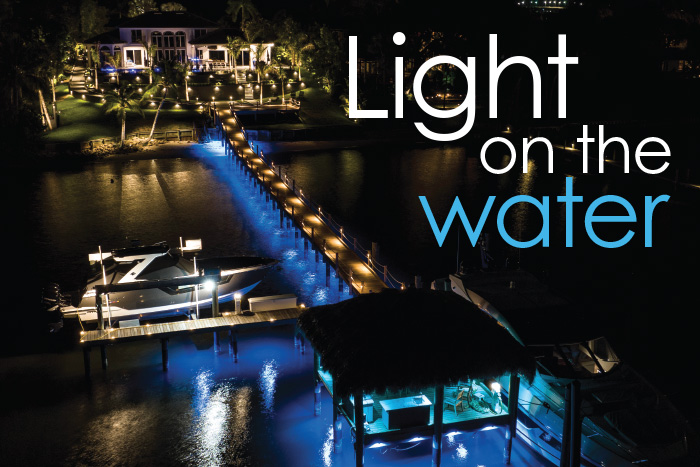 A good landscape lighting design has to take into consideration the environment surrounding the property. That environment typically doesn’t mean working from paddleboards to get just the right light effects on the water’s surface. But that’s what Greg Matthews, CLVLT, COLD, owner of Luxury Illumination in Palm Beach, Florida, took on in the design that won his team the 2023 Changing the Landscape Award for Landscape Lighting, sponsored by Brilliance LED.
A good landscape lighting design has to take into consideration the environment surrounding the property. That environment typically doesn’t mean working from paddleboards to get just the right light effects on the water’s surface. But that’s what Greg Matthews, CLVLT, COLD, owner of Luxury Illumination in Palm Beach, Florida, took on in the design that won his team the 2023 Changing the Landscape Award for Landscape Lighting, sponsored by Brilliance LED.
Luxury Illumination, started in 2015, has handled larger lighting installations in at least 15 states. It also covers outdoor audio installations for many of these projects. On average, their projects include between 250-400 fixtures, though sometimes it can reach 700.
The lighting project was part of the client updating an older property, improving the grounds and house. Matthews was brought in through referral from an electrician to handle the outdoor lighting and audio for the entire lot, running the distance from the parking area all the way back to the dock extending from the back of the building.
Keeping it classy
While Matthews’ general practice is to develop installations using softer lighting options and hiding light sources to accentuate the features being lit, this client was looking for something a little different.
“The client owned a yacht brokerage, and he wanted somewhere to be able to show off his boats and bring clients,” Matthews says. “They wanted to go out and be able to enjoy the spaces at night to their fullest potential.”
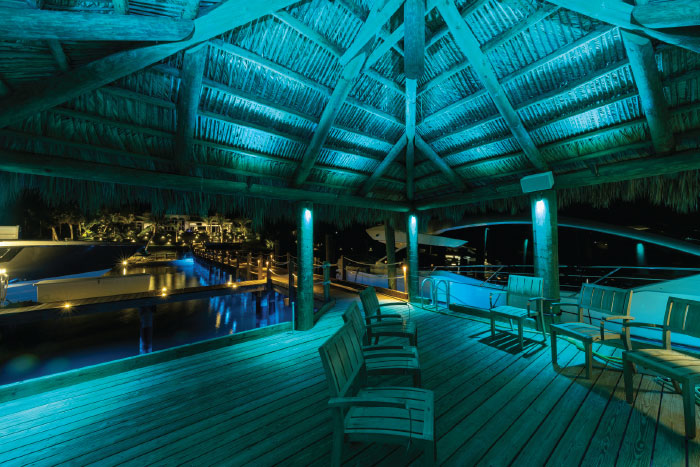
Given that the client lived on the property with their children, the design needed to strike a balance between eye-catching appeal and practical functionality for daily life. That meant a focus on developing the design around the underlit docks, says Matthews. They could’ve just done nose lights across the dock or chosen not to use color in the design’s palette, but the owner was looking for more. In the end, they developed a concept that made the docks visible from the main roadway without being gaudy.
“It’s something that stands out compared to all the neighbors, and we also still kept it classy,” he says.
The client was also looking for a splash of color in the design. The tiki hut in the back of the property brings some blue into the layout for a different atmosphere, but it can be changed to fit whatever mood the owner is looking for. “It can obviously be white or any Kelvin temperature when you don’t want it to be color, but when you do want to have a party or something more eventful, it’ll adapt,” he says.
Initially, the client had requested that the entire backyard design would incorporate blue, but Matthews talked them into using it as an accent instead.
“We were still able to base it with a warm color temperature throughout the property and keep it evenly lit, and then lead to a dramatic focal point of the blue on the dock, with the color-changing ability on the tiki hut,” he says. “That left the front yard very classy as well.”
The facade of the house as well as the trees and other key areas in the front are lit with standard white to make for a more dramatic reveal.
“When you’re driving in, it leads you up to the design,” he says. “The front entry and gate are all 3,000 Kelvin, so you don’t see any of the back dock until you walk through the home and out the back door. That’s just another feature to look at.”
One of Matthews’ best tools when walking a client through design options is a portfolio that covers multiple projects they’ve worked on with different approaches and layouts, he says.
“Luckily, we’ve done some other work like this, and I was able to portray the design I was giving to the client through the images of work we’ve already done,” he says. “That allows them to visualize what it’s going to look like at the end, but it also allows them to see a proof of concept.”
When the client has that reassurance, it makes it easier to approach small changes in the overall project to make the lighting design that much stronger. For one area of the house, Matthews noticed that the white lights were spotlighting a bright white wall, looking like a hotspot rather than providing illumination. Rather than choose custom fixtures for that area, he talked to the client, who was willing to have the wall painted a slightly darker gray to tone down the intensity.
“Not only does the lighting look better, but it looks a lot better overall during the day and night,” he says.
As Matthews establishes trust with his client, he’s able to talk with the client about those small property changes that will make for a stronger lighting design, he says. Bringing the client in on it helps them feel heard in the process, which can improve how they feel about the end product.
“Lots of times we’ll have a client plant a tree or something if they’re missing an area of light on the property,” Matthews says. “They appreciate it, most of the time, as we’re just trying to improve their property for them.”
Designing for a dock
Because a dock comes with safety concerns, the lighting design had to also provide enough light and guidance to keep visitors from accidentally falling off. For the golf cart path leading out to the dock, Matthews installed MR8 fixtures with a teak finish to match the look. The path ramps up and then slopes back down, and to match the curvature, his team cut the base of each fixture at an angle so that the effect was a level, straight illumination despite the grade. They installed surface-mount lights on the posts at the edge of the dock and some recessed lighting into steep stairways and the access areas to reach the boats pulled up to the docks.
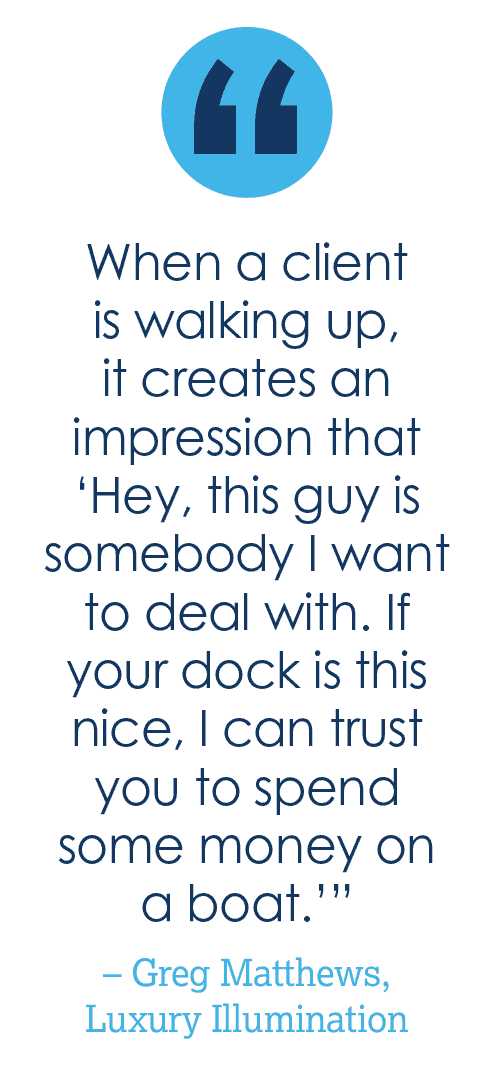 While the lighting design serves a safety need, it’s also delivering on an experience for the homeowner and any visiting customers. To create enough light for any boats that could be potentially docked there, multiple light sources were installed along the dock.
While the lighting design serves a safety need, it’s also delivering on an experience for the homeowner and any visiting customers. To create enough light for any boats that could be potentially docked there, multiple light sources were installed along the dock.
“When a client is walking up, it creates an impression that ‘Hey, this guy is somebody I want to deal with. If your dock is this nice, I can trust you to spend some money on a boat,’” says Matthews. “We started from a place of how we could make him look better at doing what he’s trying to do.”
Matthews wanted to make certain that the dock sold that experience. It would’ve been possible to use just a single blue light between each pile to illuminate the space, but the effect wouldn’t have been correct. “You wouldn’t have gotten that cool glow,” he says. “We had to double them up and place them toward the sidewalls of the dock. It creates more blue, but what it really does is increases the width of the blue light dramatically. Now your light is coming out farther and as you’re walking down the dock you can see the blue light below. It would be an entirely different feel.”
Doubling the blue lights and finding the right placement between the piles develops that continuous feel of illumination throughout. It’s easy to say that a design with more fixtures gives the opportunity to sell more to the client, but Matthews points back to matching the design to the client’s needs.
“It’s about designing it properly and portraying it to the client properly,” he says. “Is it about selling more lights? No, it’s about getting the greatest effect.”
In the front area of the property, Matthews’ team worked with the hardscaping to make certain that the full area was covered. That meant running wire through the gutters and around the facade of the house itself to mount lights covering the driveway and other elements. “If we hadn’t put in the effort and had just lit up the trees, you’d have some major black voids in the middle property,” he says. Getting even coverage that avoided those dark points and hotspots meant multiple points of drilling into hardscaping or moving with pavers for wiring.
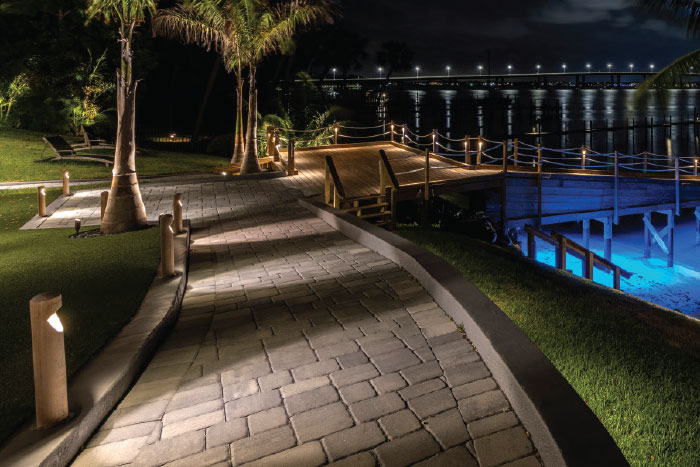 Even if the installation is meant to be done in phases, Matthews does as much as he can in the first stage so that later steps are easier to handle. That can mean working the wiring for later lighting additions or audio or even just running sleeves where they’re likely to be needed into the first installations, he says. Subsequent phases will be a little easier to handle and cost less, making it more likely for the client to go for them.
Even if the installation is meant to be done in phases, Matthews does as much as he can in the first stage so that later steps are easier to handle. That can mean working the wiring for later lighting additions or audio or even just running sleeves where they’re likely to be needed into the first installations, he says. Subsequent phases will be a little easier to handle and cost less, making it more likely for the client to go for them.
Planning ahead might even create a situation where you get to show your expertise to a client when they notice where the first phase comes a little bit short of their initial dream, he says.
“After you’ve done the first phase, they might say, ‘Oh, why is it dark over there?’ You have the opening to say ‘We planned for that phase, but you didn’t approve it yet,’” he says. “It makes you look better.”
Facing the front yard was one stage, but handling the installations under the docks and facing the waves took another approach entirely. Matthews started by using drones to take aerial photos and get a solid idea of where and how the design would actually be placed on the piles. That helped them understand the differences in spacing so they could avoid staggering in the light effect as compared to the nose lights on top of the dock.
Riding the waves
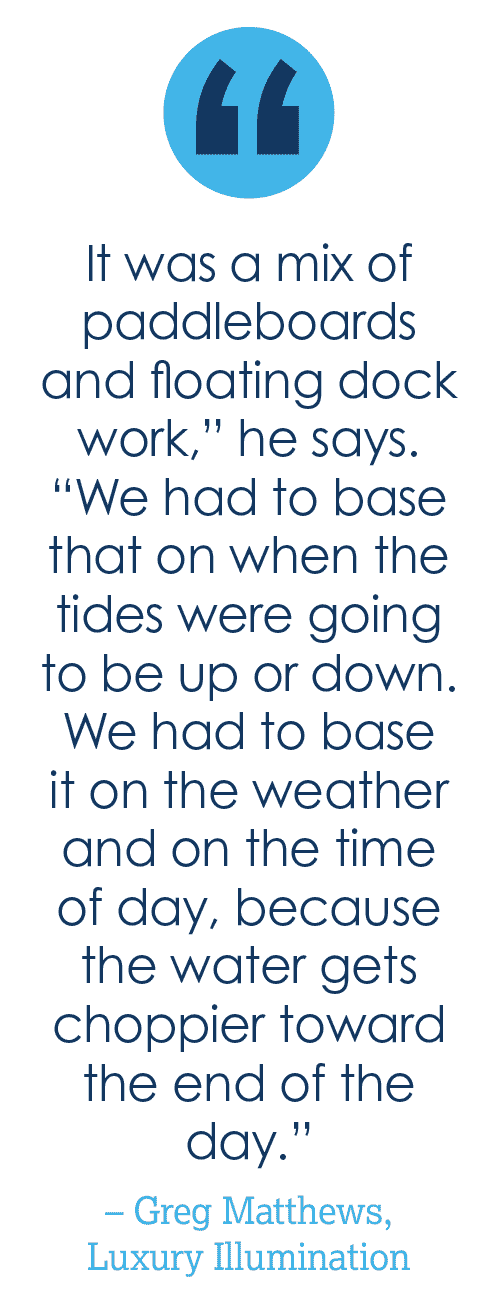 Installing the wiring underneath the dock was a balancing act of multiple factors. For the most part, they used a small floating dock of about 3 feet by 6 feet made of Styrofoam and a plank on top. Waiting until the tide was all the way out to work on the dock wasn’t an option, as it was too high up at that point. When the tide was all the way in, there wasn’t room to work.
Installing the wiring underneath the dock was a balancing act of multiple factors. For the most part, they used a small floating dock of about 3 feet by 6 feet made of Styrofoam and a plank on top. Waiting until the tide was all the way out to work on the dock wasn’t an option, as it was too high up at that point. When the tide was all the way in, there wasn’t room to work.
“It was a mix of paddleboards and floating dock work,” he says. “We had to base that on when the tides were going to be up or down. We had to base it on the weather and on the time of day, because the water gets choppier toward the end of the day.”
His team did as much work on building, checking and wiring the system on dry land as possible before moving the parts, carefully, from the docks down to the waiting crew member on a float to do the last parts of the installation.
“You’re not trying to do complicated connections below the dock,” he says. “If you start doing that, you’re not going to have the best connections all of the time. And then you’re also dropping tools in the water. It gets tricky working from the dock.”
This 170-foot dock isn’t the first above-water installation Matthews has worked on. Using ladders along the side has worked in a few situations, but the floating dock has been the most effective for him when they’ve had the space to lay out the system and do the work aboveboard before taking it underneath. For this project, it took multiple disparate wire feeds to get the appropriate power to the under lights, as well as a separate feed for the above-dock lights.
The ocean itself didn’t cause too many issues, though Matthews’ team did have to stop occasionally for bad weather or a speeding boat. A curious shark came by to check out the work at one point, and at least one drill was lost to the ocean.
“A few extra expenses here and there,” he jokes.
It also takes extra effort by the workers beneath the dock, as they’re not only installing fixtures but balancing at all times with every muscle in their body, he says. It’s important not only to have a crew who are well-trained, but who are excited and skilled enough to take on odd designs like these.
“It’s not like you’re just tying something together on land, you can’t do it quite so quickly, so you have to spread out the work a bit more.”
 Working with water also brought on additional considerations in the fixture choice, Matthews says. The lamps and fixtures had to be able to stand up to the weather and water pressures, and easy enough to install that if one needs to be swapped out, it’s not an impossible task.
Working with water also brought on additional considerations in the fixture choice, Matthews says. The lamps and fixtures had to be able to stand up to the weather and water pressures, and easy enough to install that if one needs to be swapped out, it’s not an impossible task.
“The second thing would be to make sure the lights have enough output, because water basically absorbs light,” he says. “When you’re illuminating from the top into a dark water area, you need something bright enough for it to reflect back up for you to see it. If you were to put a 3-watt fixture out there, it’s not going to be very impactful or what the client is looking for.”
Beam spread was another point to check, as a wider range kept the light from spotlighting on the water’s surface, he says.
“We’re looking for wide, durable and consistent,” he says.
In the tiki hut itself at the end of the dock, Matthews used up lighting into the ceiling for multiple effects. It creates a more relaxing space without the intensity of down lights, he says, and is safer because it doesn’t force visitors’ eyes to adjust quickly as the move from the brightness of the hut to the exterior of the dock.
“You want an even flow of lighting throughout the property where they’re going to utilize it, especially if there are safety concerns,” he says.
Altogether, the client was thrilled with the finished installation, including the dock and its glow over the surface of the water, he says.
“Our company tagline is that we change lives one night at a time,” Matthews says. “That’s what we really feel it does for the client because you’re allowing them to live in that space longer and enjoy it longer and make new friends.”

